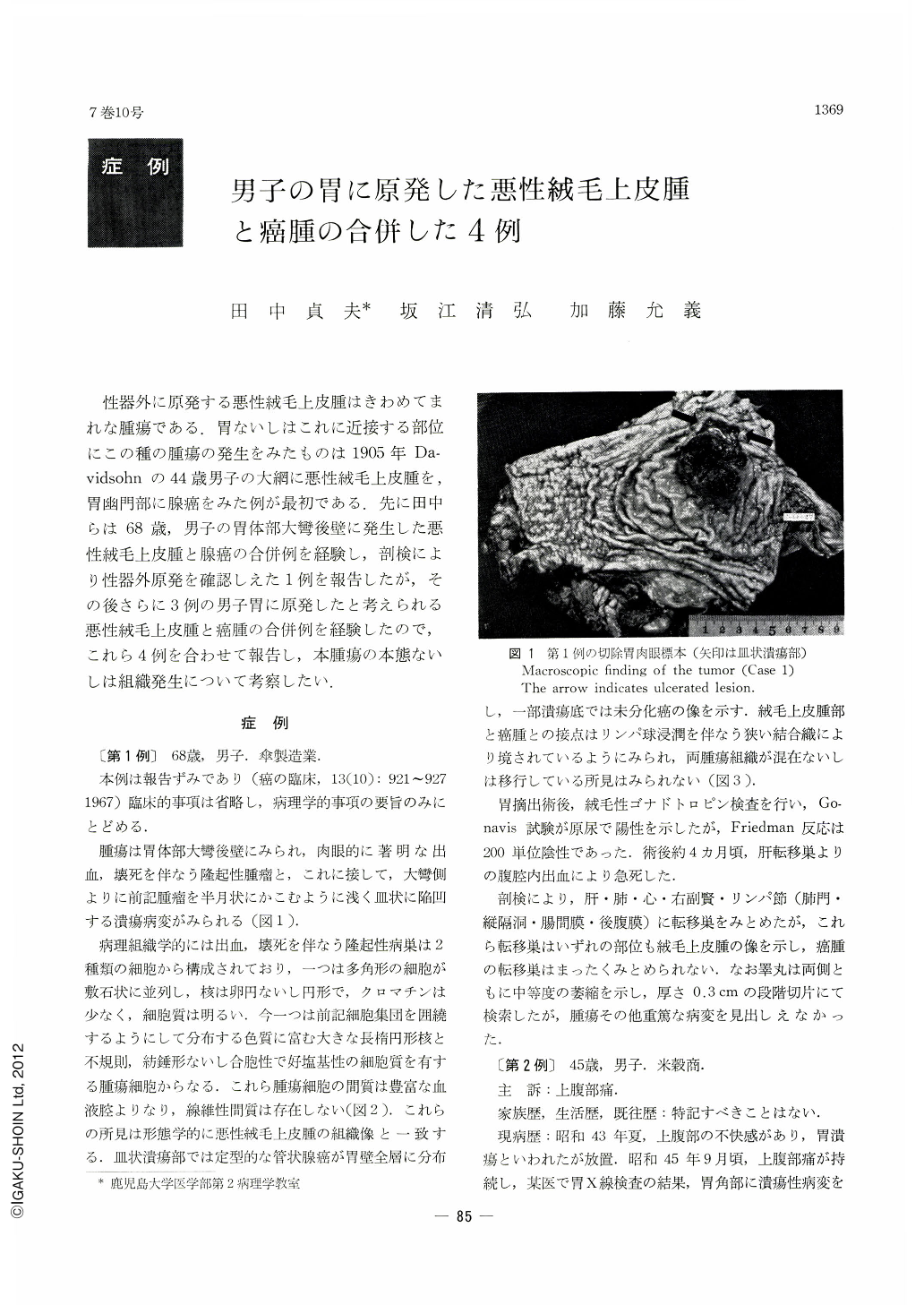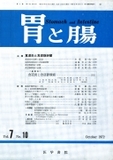Japanese
English
- 有料閲覧
- Abstract 文献概要
- 1ページ目 Look Inside
性器外に原発する悪性絨毛上皮腫はきわめてまれな腫瘍である.胃ないしはこれに近接する部位にこの種の腫瘍の発生をみたものは1905年Davidsohnの44歳男子の大網に悪性絨毛上皮腫を,胃幽門部に腺癌をみた例が最初である.先に田中らは68歳,男子の胃体部大彎後壁に発生した悪性絨毛上皮腫と腺癌の合併例を経験し,剖検により性器外原発を確認しえた1例を報告したが,その後さらに3例の男子胃に原発したと考えられる悪性絨毛上皮腫と癌腫の合併例を経験したので,これら4例を合わせて報告し,本腫瘍の本態ないしは組織発生について考察したい.
症例
〔第1例〕68歳,男子.傘製造業.
本例は報告ずみであり(癌の臨床,13(10):921~927 1967)臨床的事項は省略し,病理学的事項の要旨のみにとどめる.
Extragenital chorionepithelioma arising primarily in the stomach is an extremely rare tumor. Only twenty three similar cases including four cases described in Japan were found in the literature. One of the reported cases in Japan was presented by one of us (Tanaka, S. et al.: Jap. J. Cancer Clinics, 13: 921~927, 1967). Three additional cases were experienced in our department since then. The purpose of this paper is to report a detailed histopathologic study of these four cases with chorionepithelioma in the stomach and to discuss the genesis of this peculiar neoplasm.
Case 1. A 68-year-old man. This case was already reported by Tanaka et al. The tumor arose in the posterior wall of the greater curvature and macroscopically appeared as an extensively hemorrhagic and necrotic elevated lesion (Borrmann I type) surrounded by a crescent-shaped shallow ulcer. Case 2. A 45-year-old man. An ulcerative lesion was observed in the angular area. On large whole tissue section, a hemorrhagic and necrotic tumor was found closely related to the base of the ulcer. Case 3 is a 46-year-old man. A huge tumor was found in the antrum. The surfase of the tumor showed marked hemorrhage and necrosis. Case 4. A 61-year-old man. A tumor was present in the greater curvature side of the antrum, but no hemorrhagic and necrotic area were observed in the tumor.
There have been several different opinions as to the genesis of the neoplasm. Davidson suggested that the tumor originated from the intra-abdominally displaced gonadal anlage. Risel, Stewart,Borrmann and Gaertner believed that the tumor only resembled chorionepithelioma (mimicry of stomach cancer). Hartz & Ramirez C and Goder thought that the extragenital or nongestational chorionepithelioma usually arose in a teratoma of displaced germinal epithelium and Stout assumed that the tumor of this case was a metastasis from genital chorionepithelioma. On the other hand, Pick suggested the retrodifferentiation of carcinoma cells with the ability to form trophoblast. Regen & Cremin supported this hypothesis. In most of the reported cases, chorionepithelioma in the stomach always coexisted with carcinoma and a positive gonadotropic hormone test was obtained in 8 out of 26 cases. So it is reasonable to presume that the carcinoma cells in the stomach could retrodifferentiate to produce tumor, indistingishable from genuine chorionepithelioma both in morphology and in function.

Copyright © 1972, Igaku-Shoin Ltd. All rights reserved.


